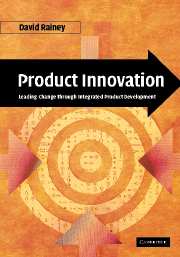Book contents
- Frontmatter
- Contents
- Preface
- Acknowledgements
- Part I Product innovation and strategic logic
- 1 Introduction to product innovation and new-product development
- 2 Strategic logic of product innovation
- 3 The new-product development process and organizational aspects
- Part II Establishing the foundation: the conceptual level
- Part III Methods and techniques for analysis and decision making
- Part IV The operational level and concluding remarks
- Glossary
- References
- Select bibliography
- Index
3 - The new-product development process and organizational aspects
Published online by Cambridge University Press: 10 August 2009
- Frontmatter
- Contents
- Preface
- Acknowledgements
- Part I Product innovation and strategic logic
- 1 Introduction to product innovation and new-product development
- 2 Strategic logic of product innovation
- 3 The new-product development process and organizational aspects
- Part II Establishing the foundation: the conceptual level
- Part III Methods and techniques for analysis and decision making
- Part IV The operational level and concluding remarks
- Glossary
- References
- Select bibliography
- Index
Summary
Introduction
This chapter describes and assesses the new-product development (NPD) process, including organizational and leadership perspectives. Successful products are generally efficient in resource utilization (easy to produce), have effective product delivery mechanisms (easy to deliver), and are beneficial to customers (easy to use).
The “standardized” NPD process includes idea generation, concept development and selection, program definition, design and development, validation, pre-commercialization, and launch. Rapid product development requires close coordination, cooperation, and linkage between all of the participants, whether virtual or actual.
Innovation is difficult to mandate but it can be fostered. It is derived from dedicated people using creativity to discover new ways of thinking and solving problems. Cross-functional team integration is the organizational structure that allows collaborative behavior in a creative environment. It is essential for ensuring that the contributions of engineering, marketing, manufacturing, finance, and the other functions are in strategic alignment. The emphasis is on teamwork, information sharing, communication, and participation at all levels in the decision process. Creating a spirit of high performance is pivotal for success.
Management encourages, motivates, and inspires the organization to discover innovative solutions that lead to pre-emptive positions and outcomes with significant competitive advantages.
Chapter 3 includes the following topics and learning objectives:
Understanding the management system (process management) for new-product development.
Defining the “standardized” NPD process with its “phases and reviews” construct.
Determining how to measure the potential risks and rewards of NPD programs using selected metrics.
Describing the six phases of the NPD process.
Understanding the organizational aspects of product innovation and how cross-functional teams are tailor-made for process management.
- Type
- Chapter
- Information
- Product InnovationLeading Change through Integrated Product Development, pp. 102 - 146Publisher: Cambridge University PressPrint publication year: 2005



